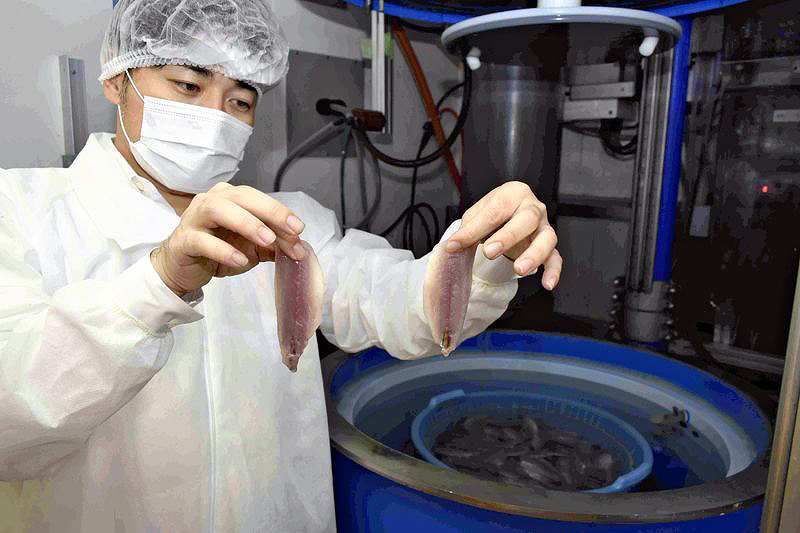
A Japan Seafoods staff member holds a horse mackerel fillet that has been treated with electrical currents, right, and an untreated fillet, left, in Higashi Ward, Fukuoka.
December 7, 2021
Raw fish, raw eggs and raw chocolate. In the Japanese diet, the emphasis on raw can be felt everywhere. Why do Japanese people prefer “raw” food?
A fillet of horse mackerel for sashimi was being soaked in a saltwater tank at a Japan Seafoods Co. factory, a seafood processing company in Fukuoka City. The tank is used to kill anisakis, a parasitic nematode or worm that lives on fish, by electrocuting them.
If a person becomes infected with anisakis, it can cause stomach pains and other food poisoning symptoms. Freezing the fish kills the parasite, but thawed sashimi is soft and discolored. A way to safely deliver raw fish without freezing the products had to be figured out.
In June, the company, along with a group of researchers led by Takao Namihira, associate professor at Kumamoto University’s Institute of Industrial Nanomaterials, developed a system that utilizes instantly generated high-powered electricity called “pulse power.”

An employee shows an egg yolk at Tamagoya in Himeji, Hyogo Prefecture.
By running a strong electrical current through the water about 500 times in six minutes, it kills the parasites from 3 kilograms of horse mackerel and does not alter its appearance, taste or texture. The company has begun shipping the sashimi on a trial basis and is working to develop equipment for mass processing.
“Being able to eat things raw is a sign of its freshness,” said Yoichi Inoue, president of Japan Seafoods. “We want to increase the value of our products by making them both safe and delicious.”
Raw fish has long been a favorite in Japan, as the country is surrounded by water. However, with the danger of food poisoning, local manufacturers are taking every precaution.
Since Hiroshima Prefecture is a major producer of farm-raised oysters, the prefectural government has designated certain areas in its waters where oysters can be cultivated for raw consumption, based on the standards set by the Food Sanitation Law. The prefectural government established guidelines for oyster farmers and requires them to report to the public health center prior to shipping their goods. The farmers also voluntarily test their oysters for norovirus and continue their efforts to produce safe raw food.
Vaccinating chickens
Not many countries eat raw eggs, but they are safe to eat in Japan because of the industry’s sanitation practices. The Health, Labor and Welfare Ministry has notified farmers to clean the eggs with disinfectant and inspect them for cracks and dirt before shipping.
Some companies have gone a step further to improve their safety. The specialty dish of Tamagoya, a restaurant in Himeji, Hyogo Prefecture, is raw eggs on rice. Fujihashi Shoten, located in Tatsuno in the prefecture, operates the restaurant and is involved in everything from raising the chickens, vaccinating them against salmonella and collecting the eggs. The eggs are delivered to the restaurant within 48 hours of being laid. Eggs that have a thicker egg white and a yolk that can be picked up with chopsticks are indicative of freshness.
“Eggs on rice is comfort food for Japanese people,” said Takashi Fujihashi, president of Fujihashi Shoten. “I want [our customers] to enjoy the taste of raw eggs, so we are very particular about what we feed our chickens to make [the eggs] richer.”
Abundance of nature
A Chinese historical book, Wei Zhi Wajin, from the third century, wrote, “[Japanese] people eat raw vegetables in both winter and summer.” With abundant nature and freshwater from the mountains, it was possible for people to eat fish and vegetables raw.
“Japanese food culture values seasonal ingredients,” Nobuo Harada, president of the Society of Japanese Food Studies and professor emeritus at Kokushikan University, said. “There is a tendency to chase the ideal, which is using fresh ingredients that are almost raw.”
During the Muromachi period (1336-1573), sashimi was soaked in hot water or treated with vinegar, for hygienic reasons, so it could be eaten as raw as possible. With the development of raw-finishing techniques, the cold chain, which is a system to maintain the low temperature required to keep foods fresh, has been established.
“For hundreds of years, Japanese people have found value in raw food, which is why they have refined their techniques and created a unique raw food culture,” Harada said.
Geography, climate and culture are just a few of the factors that have fostered the love Japanese people have for raw food.
"Society" POPULAR ARTICLE
-

M4.9 Earthquake Hits Tokyo, Neighboring Prefectures
-

Israeli Tourists Refused Accommodation at Hotel in Japan’s Nagano Pref., Prompting Protest by Israeli Embassy and Probe by Prefecture
-

M7.5 Earthquake Hits Northern Japan; Tsunami Waves Observed in Hokkaido, Aomori and Iwate Prefectures
-

Tsukiji Market Urges Tourists to Avoid Visiting in Year-End
-

High School in Kyoto Says Students Shoplifted during Recent School Trip to Bali, Indonesia
JN ACCESS RANKING
-

Tokyo Economic Security Forum to Hold Inaugural Meeting Amid Tense Global Environment
-

Keidanren Chairman Yoshinobu Tsutsui Visits Kashiwazaki-Kariwa Nuclear Power Plant; Inspects New Emergency Safety System
-

Imports of Rare Earths from China Facing Delays, May Be Caused by Deterioration of Japan-China Relations
-

University of Tokyo Professor Discusses Japanese Economic Security in Interview Ahead of Forum
-

Japan Pulls out of Vietnam Nuclear Project, Complicating Hanoi’s Power Plans























